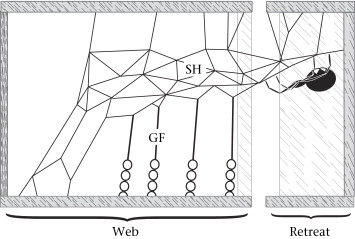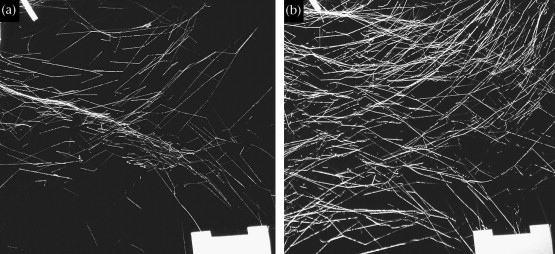Behavior
L. hesperus is, contrary to popular belief, a relatively tame, calm spider. They aren't likely to bite unless provoked. This has been proved through research which has concluded that they only bite or attack when pinched, roughly poked or they feel their egg sac is being threatened. The spiders are much more likely to retreat and flee from danger (Nelsen et al. 2012).
This video clip is a great representation of L. hesperus' tendency to retreat more than attack.
Another interesting facet to these fascinating creatures is that research has shown that, depending on their hunger level, the spiders will spin webs of different architecture. Below is an example of the 'cobweb' structure of the Latrodectus web.

Photo found in Blackledge and Zevenbergen 2007
The retreat is a region of the web that the spider goes to for
protection and spends most of its time. (SH) are sheets of thread
that make up the body of the web. (GF) are the sticky gumfooted
threads that cause prey to become stuck to the web, as the name
hints at.
According to Blackledge and Zevenbergen 2007, the cobweb spiders' web has evolved from the orb-web spiders (the traditional spider web that most would associate spiders with). The cobweb, which is three dimensional, is most different from the orb-web, which is two dimensional, when comparing the level of protection it gives the spider. The cobweb allows the spider to rest in a region of the web not exposed to predators along with early detection of any predator closing in (Blackledge and Zevenbergen 2007).
Blackledge and Zevenbergen 2007 performed an
experiment testing the change in web size and structure of L.
hesperus depending upon nutrient levels. They determined the
original size of the spider by weighing it and measuring the length
of the spiders femur, which does not change depending on what stage
of molting it is in. The spiders were divided into two groups
differing in the amount they were fed daily for six days (one
cricket vs. fasting). They performed two trials in which they
reversed the feeding regimen of the two groups. The researchers
collected the spiders webs after the six day treatment. They then analyzed the webs by quantifying the amount of sheets of
thread and the number of sticky gumfooted threads by weight and
number respectively. They weighed the spiders after each treatment
as well.
The researchers found that fasting spiders spun webs that concentrated on catching food in the short run whereas spiders that had been fed spent more energy creating stronger webs designed more for protection then food capture. The individual threads of the web of fed spiders were also TWO TIMES the diameter of fasting spiders.

Photo found in Blackledge and Zevenbergen 2007
Picture (a) is the web of a fasting spider. Picture (b) is the web
of a fed spider.
